1. Introduction
In recent years, fashion analysis technology (e.g., compatibility modeling) has attracted widespread attention and demonstrated great commercial value and research potential. The Compatibility Modeling (CM) methods aim to calculate the compatibility score among complementary fashion items (i.e., top, bottom, shoes, and accessories) and thus achieve compatible item recommendations. At present, existing CM methods [1,2] typically utilize multi-modal information (e.g., images and textual descriptions) on fashion items to evaluate the compatibility of complementary items. For example, Yang et al. [3] established an end-to-end learning method, integrating the complementary relationships of specific categories into the item embedding space for unified optimization. Although the above method considers item information from different modalities, it ignores fine-grained attribute learning, resulting in a lack of interpretability in recommendations. Later, Lin et al. [4] proposed a scalable method to learn the attention of style-based subspaces to enhance compatibility
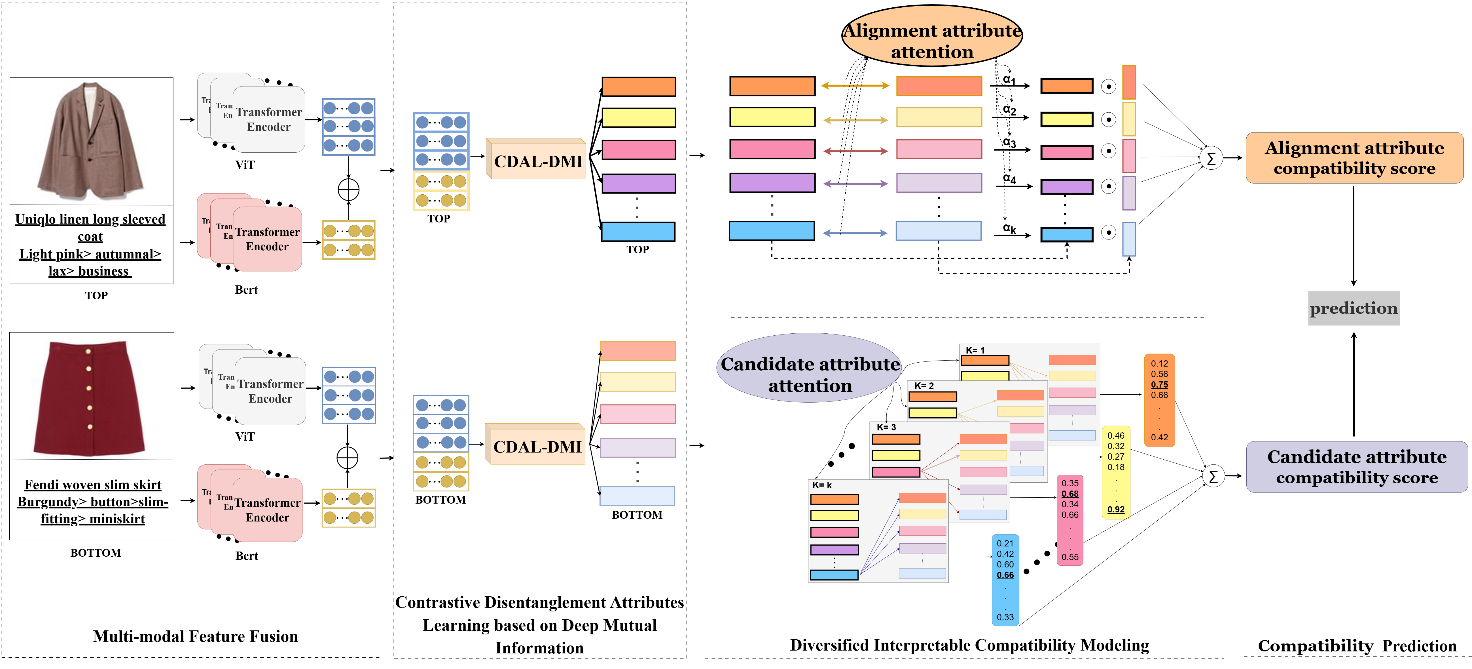
prediction. However, the limited number of subspaces resulted in insufficient interpretability. Due to the remarkable performance of disentanglement representation learning [5-8] in extracting interpretability factors, some researchers have introduced it into interpretable CM. For instance, Liu et al. [9] disentangled the representations of different modalities into k blocks based on covariance and learned the role of each block in the recommendation. In addition, CM methods also integrate multiple techniques, such as graph neural networks [10,11] and attention mechanisms [12,13] to improve compatibility modeling performance.
Although the aforementioned approaches have achieved certain results, the following limitations still persist: (1) The methods described above merely model the compatibility of the aligned attributes between items (e.g., the color and category attributes when matching a white T-shirt with black pants), ignoring the impact of candidate attributes on compatibility modeling. In fact, the top "black and white striped vest" is matched with both the "black wide-leg long skirt" and "black straight-leg long skirt" in terms of aligned attributes, but when further considering their candidate attributes, the "V-neck" and "wide-leg" are more compatible than the "straight-leg". Therefore, it is necessary to consider the candidate attributes to improve the diversity of compatibility modeling. (2) The disentanglement method in the compatibility modeling work mentioned above ignores the possibility of redundant information within the partitioned blocks. In addition, some frameworks [14,15] use specialized region encoders to learn the local attributes of items but overlook the fact that a limited number of attributes cannot meet the diverse matching requirements among items. Especially when dealing with high-dimensional continuous representations of items, these methods are difficult to adjust according to the complexity of the data. Therefore, it is essential to design a disentanglement method according to the characteristics of the multi-modal representation of fashion items to enhance the interpretability of recommendations and meet the diverse attribute matching methods of the items.
Accordingly, to address the above research limitations, we devise a Diversified Interpretable Compatibility Modeling based on Multi-modal Disentanglement framework, termed DICM-MD. Figure 1 illustrates our proposed method, which involves multi-modal feature fusion, contrastive disentanglement attributes learning based on deep mutual information, diversified interpretable compatibility modeling, and a compatibility prediction module. Specifically, DICM-MD adopts deep neural networks to evaluate the mutual information between dimensions when facing high-dimensional continuous representations of items and gradually optimizes its independence based on contrastive loss functions, encouraging each dimension to learn independent information. This measure is beneficial for disentangling rich attribute representations and improving the interpretability of recommendations. Then, considering the complexity of attribute matching between complementary items, DICM-MD uses the attention mechanism for diversified interpretable compatibility modeling, which comprehensively describes the compatibility degree of complementary items from the perspective of the alignment attribute and candidate attribute.
Our main contributions can be summarized as the following three points:
(1) We propose a multi-modal disentanglement method named Contrastive Disentangled Attribute Learning based on Deep Mutual Information (CDAL-DMI), which is to evaluate the mutual information among dimensions of high-dimensional continuous representations and constrains their independence based on contrastive loss. To the best of our knowledge, we are the first to utilize mutual information to disentangle item attributes in compatibility work.
(2) We design a Diversified Interpretable Compatibility Modeling method (DICM) to comprehensively evaluate the compatibility between complementary items through the diverse compatibility scores from two perspectives: alignment attribute and candidate attribute.
(3) We conducted extensive experiments on the real datasets IQON3000 and Polyvore, and the results validated the superiority of DICM-MD over advanced baselines.
2. Related work
2.1. Fashion compatibility modeling
The prosperity of the fashion field has drawn researchers' attention to fashion analysis, leading to the emergence of a variety of CF frameworks for evaluating the matching degree between fashion items. Previous CF methods [16,17] solely utilized single-modal information (e.g., visual or textual) of fashion items, neglecting the potential of multi-modal information. As a result, most existing works have gradually shifted their focus to multi-modal compatibility modeling (e.g., visual images and textual descriptions). For instance, Li et al. [18] employed RNN networks to predict the next complementary item. Later, Goto et al. [19] designed an autoencoder based on long short-term memory (LSTM) networks to mine style information from items. However, sequential structures are more suitable for predicting the compatibility of multiple clothing items rather than just top-bottom pairs. Given the superior performance of graph neural networks in learning structural features, some researchers have utilized graph neural networks to model item compatibility. For example, Cui et al. [10] proposed node-wise graph neural networks to model various forms of clothing compatibility. Although these methods achieved certain results, their recommendation processes lack interpretability. Therefore, Lin et al. [4] introduced an expandable approach to learn style-based subspace attention for enhancing compatibility prediction. However, the limited number of subspaces leads to insufficient interpretability. In reality, the compatibility between fashion items depends on attribute pairings, yet existing approaches only focus on matching alignment attributes. In contrast, we model the diversified matching patterns of fashion items from both alignment and candidate attribute perspectives. Table 1: Rules to format sections
2.2. Disentanglement representation learning
Disentanglement representation learning aims to learn the latent factors present in the observed data. Due to its robustness and interoperability, some articles introduce disentanglement representation learning to solve complementary term recommendation tasks. For example, Wang et al. [27] designed a graph-based disentanglement representation learning scheme that exploits the compatibility between different parts of an item to accomplish complementary recommendations. Similarly, Wang et al. [22] learn disentangled representations between heterogeneous information of items to complete the recommendation task. Despite the results achieved by these approaches, their delineation of item attributes is not comprehensive. Therefore, Liu et al. [9] proposed to use the distance between item attributes as a regularization term to learn the disentanglement attribute representation, but this approach cannot capture the non-linear relationship between attributes, so it cannot divide the attributes effectively.
Inspired by the above work, we propose a comparative disentanglement attributes learning method based on deep mutual information, which employs deep neural networks to learn the mutual information between different dimensions of item representations and then imposes independence constraints on each dimension using contrastive loss. Our approach aims to encourage each dimension in the high-dimensional continuous representation of fashion items to learn independent attribute representations, thereby preparing for subsequent modeling of attribute matching patterns.
3. Methodology
3.1. Problem formulation
We have a set of tops and bottoms denoted as
where
3.2. Mutli-modal feature fushion
Currently, pre-trained models have been extensively employed and have achieved remarkable success in the field of computer vision [23,24]. Consequently, we utilize the pre-trained Vision Transformer (ViT) to extract the visual feature
To obtain the textual feature
In fact, different modalities can express different attribute information of fashion items. In order to comprehensively explore the potential of multi-modal in compatibility modeling, we concatenate the visual feature
3.3. Contrastive disentanglement attributes learning based on deep mutual information
As a matter of fact, the compatibility between complementary items is significantly influenced by the attributes of the items. Existing multi-modal compatibility modeling methods mainly focus on computing the compatibility directly based on the overall feature within a latent compatibility space (e.g., style space [25]). Nevertheless, they ignore the effect of repetitive and redundant information in multi-modal attributes on compatibility modeling. In order to increase the independence within the multi-modal attributes and improve the interpretability of compatibility modeling, we designed the Contrastive Disentanglement Attributes Learning based on Deep Mutual Information (CDAL-DMI).
Mutual information was first proposed to measure the degree of dependence between variables [26]. Given two variables
where
In order to further promote the independence among the attributes of fashion items. we construct the following contrastive loss
where
3.4. Diversified interpretable compatibility modeling
Based on the disentangled item attributes
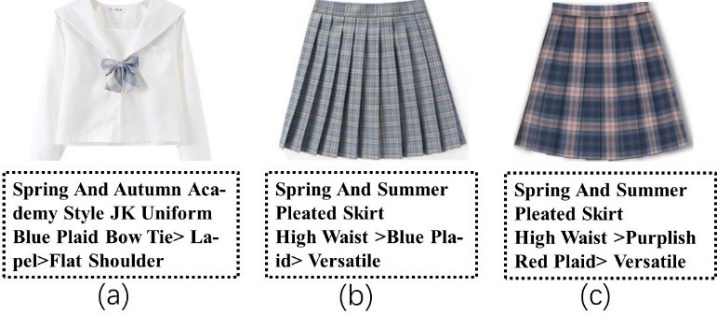
methods between item attributes from two perspectives to improve the interpretability of complementary recommendation tasks.
Alignment attribute compatibility modeling: We usually pick complementary items based on alignment attributes in actual clothing matching. For example, both bottoms (b) and (c) in Figure 5 are plaid pleated skirts. Nevertheless, the bow of the top (a) matches the color of the bottom (b), and both share the text description of “blue plaid". Consequently, considering the alignment attribute between complementary items (i.e., color), bottom (b) is more compatible with the given (a) than (c). We first calculate the alignment attribute weight
where
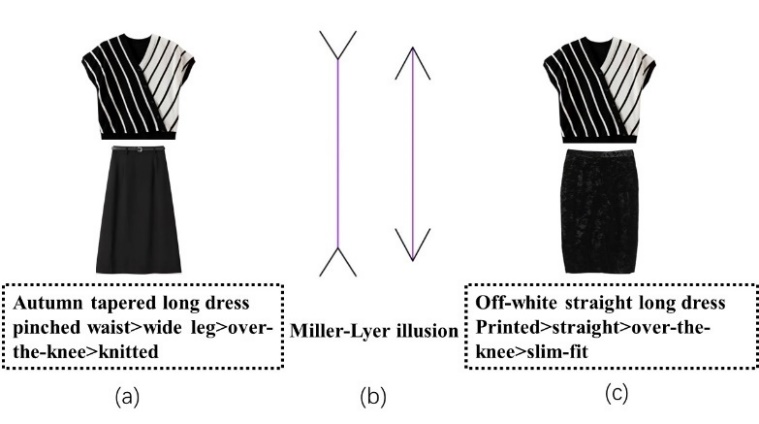
Candidate attribute compatibility modeling: As a matter of fact, relying solely on the alignment attribute between complementary items is inadequate for compatibility evaluation. It is imperative to incorporate candidate attributes to improve the performance of compatibility modeling. For example, in Figure 6, the “black and white striped vest" matches well with the two “black long dress" in terms of alignment attributes (i.e., color). However, when further considering the features of the neckline and hem, a more optimal match emerges between the “wide-leg long" dress and the “V-neck" vest. This may be mainly attributable to the Miller-Lyer illusion in Figure 6, which makes the match in Figure 6(a) visually elongate a person's height. Consequently, we introduce the candidate attribute compatibility modeling and calculate the candidate weight
Unlike the alignment attribute compatibility modeling, we select the attribute corresponding to the maximum weight
3.5. Objective loss
Based on the diversified compatibility score
where
In order to accurately model the compatibility between items, we utilize the Bayesian Personalized Ranking (BPR) framework to construct the following triad
where the triple
We jointly optimize the mutual information contrastive loss
where
4. Experiment
To evaluate the proposed DICM-MD model, we conducted a series of experiments on two public fashion datasets to address the following questions:
(1) Does our proposed DICM-MD framework outperform the state-of-the-art baselines?
(2) How does each component affect the proposed DICM-MD framework?
(3) How does the DICM-MD perform in the complementary item retrieval task?
Dataset: To validate the effectiveness of our proposed DICM-MD model, we leverage two public datasets: IQON3000 and Polyvore. The former contains 308,747 outfits, totaling 672,335 fashion items (e.g., tops, bottoms, and shoes). The latter consists of 66,000 outfits, totaling 158,503 fashion items. Each item in both datasets is associated with a visual image and a descriptive title.
Evaluation indicators: We adopted Area Under Curve (AUC) and Mean Reciprocal Ranking (MRR) [29] to measure the effectiveness of the DICM-MD model. Formally, we defined the AUC as follows:
where
where
Experiment Settings: We utilized Adam [30] to optimize our proposed DICM-MD model. Specifically, the batch size and learning rate are searched from [32,64,128,512,1024] and [0.0001,0.0005,0.005,0.001], respectively. The Loss
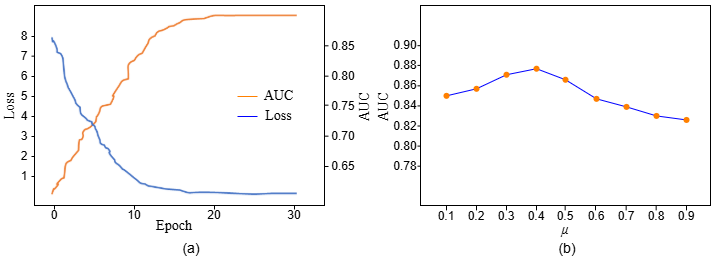
4.1. Model comparison(RQ1)
In order to scientifically evaluate our DICM-MD model, we compared it with the following baselines:
(1) POP: The compatibility is determined by the number of tops in the training set that are matched with the bottom
(2) RAND: We randomly assign the score
(3) Bi-LSTM [31] models the given items as a sequence to predict the next compatible item.
(4) V-BPR [17] models the compatibility between items solely based on their visual features.
(5) AHGN [32] constructs a heterogeneous graph utilizing the visual attributes of items, which learns the interaction information between items.
(6) VT-BPR: We extended the V-BPR to evaluate the compatibility with multi-modal data.
(7) MNLFF [33] learns hierarchical multi-modal representations and assesses the compatibility between complementary items based on the scores between them.
(8) PAI-BPR [34] learns the attribute information of the item via the visual modality and subsequently integrates the corresponding textual modality for compatibility modeling.
(9) MDR [15] disentangles multi-modal features in a partially supervised manner to achieve interpretable recommendations.
(10) FCM-CMAN [12] learns its disentangled representation hierarchically over the multi-modal information of the item.
(11) LGMRec [11] focuses on learning the disentangled information of items based on the global and local graphs.
Table 1 shows the performance comparison of different baselines, we can observe the following: (1) Compared with pop and rand, Bi-LSTM performs better, which indicates the necessity of item interactions in compatibility modeling. (2) V-BPR and AHGN outperform Bi-LSTM, suggesting that content-based approaches provide more item information than sequence-based approaches for compatibility modeling. (3) The methods (V-BPR and AHGN) that rely solely on the visual modality exhibit lower performance than other multi-modal methods, primarily due to the additional attribute features provided by the textual information. (4) FCM-CMAN, LGMRec, and MDR outperform PAI-BPR and MNLFF, demonstrating that disentanglement improves the compatibility modeling of complementary items. (5) The DICM-MD results proves the necessity of incorporating diversified interpretable compatibility modeling in complementary recommendation tasks.
|
Methods |
IQON3000 |
Polyvore |
|||
|
AUC |
MRR |
AUC |
MRR |
||
|
POP |
0.6039 |
0.2049 |
0.6072 |
0.2087 |
|
|
RAND |
0.5003 |
0.2137 |
0.5059 |
0.2162 |
|
|
Bi-LSTM |
0.6746 |
0.3354 |
0.6693 |
0.3423 |
|
|
V-BPR |
0.7863 |
0.6508 |
0.7881 |
0.6791 |
|
|
AHGN |
0.7955 |
0.6972 |
0.8033 |
0.7011 |
|
|
VT-BPR |
0.8205 |
0.8097 |
0.8297 |
0.8118 |
|
|
MNLFF |
0.8397 |
0.8144 |
0.8451 |
0.8255 |
|
|
PAI-BPR |
0.8554 |
0.8174 |
0.8537 |
0.8267 |
|
|
MDR |
0.8597 |
0.8204 |
0.8692 |
0.8388 |
|
|
FCM-CMAN |
0.8643 |
0.8304 |
0.8722 |
0.8491 |
|
|
LGMREC |
0.8689 |
0.8361 |
0.8871 |
0.8593 |
|
|
DICM-MD |
0.8848 |
0.8463 |
0.8961 |
0.8677 |
|
|
Datesets |
Evaluation |
IBR |
VBPR |
HFGN |
VTBPR |
PAI-BPR |
DICM-MD |
|
QON3000 |
NDCG@10 |
0.1628 |
0.2366 |
0.2393 |
0.2467 |
0.2567 |
0.3317 |
|
NDCG@15 |
0.2076 |
0.2790 |
0.2841 |
0.2874 |
0.2845 |
0.3722 |
|
|
NDCG@20 |
0.2489 |
0.3128 |
0.3172 |
0.3207 |
0.3386 |
0.4000 |
|
|
HR@10 |
0.3463 |
0.4767 |
0.4815 |
0.4967 |
0.5087 |
0.6080 |
|
|
HR@15 |
0.5194 |
0.6545 |
0.6588 |
0.6707 |
0.6802 |
0.7614 |
|
|
HR@20 |
0.6870 |
0.7973 |
0.7990 |
0.8100 |
0.8125 |
0.8790 |
|
|
Polyvore |
NDCG@10 |
0.4365 |
0.5057 |
0.5373 |
0.5467 |
0.5532 |
0.6470 |
|
NDCG@15 |
0.4519 |
0.5217 |
0.5460 |
0.5612 |
0.5715 |
0.6678 |
|
|
NDCG@20 |
0.4764 |
0.5391 |
0.5670 |
0.5931 |
0.6133 |
0.6788 |
|
|
HR@10 |
0.6276 |
0.7307 |
0.7539 |
0.7678 |
0.7703 |
0.8338 |
|
|
HR@15 |
0.7739 |
0.7946 |
0.8082 |
0.8109 |
0.8145 |
0.9090 |
|
|
HR@20 |
0.8183 |
0.8371 |
0.8559 |
0.8712 |
0.8707 |
0.9557 |
To further validate the effectiveness of our DICM-MD model, we employed two ranking metrics widely used in recommender systems: Hit Rate (HR), and Normalized Discounted Cumulative Gain (NDCG), Specifically, HR evaluates the compatibility of the top K items recommended by our model with the given item, and NDCG considers the position of the recommended item in the ranking list. Table 2 presents the recommendation results of different models in terms of the HR@K and NDCG@K. From this table, we can observe that: (1) VT-BPR performs poorly, suggesting that the complementary recommendation task cannot be performed without mining deeper representations in multi-modal information. (2) FCM-CMAN, LGMRec, and MDR perform better than MNLFF and PAI-BPR, which further demonstrates the advantages of disentanglement representation learning for complementary recommendation tasks. (3) Our proposed DICM-MD model performs optimally. This strongly indicates that the joint use of contrastive disentanglement attributes learning and diversified interpretable compatibility modeling is highly effective in complementary item recommendation tasks.
4.2. Ablation study(RQ2)
To verify the effectiveness of each component of our DICM-MD model, we conducted ablation studies on the following derivatives:
(1) w/o-Disen: We removed the contrastive disentanglement module to verify the compatibility performance.
(2) w/o-Candidate: In order to verify the effect of the diversified interpretable compatibility modeling, we removed the candidate attribute compatibility modeling module.
(3) w/o-Alignment: Similar to (2), we removed the alignment attribute compatibility modeling module.
(4) w/o-V: To investigate the role of different modalities in DICM-MD, we removed the visual feature from the model.
(5) w/o-T: Similar to (4), we removed the textual feature from the DICM-MD.
|
Methods |
IQON3000 |
Polyvore |
||
|
AUC |
MRR |
AUC |
MRR |
|
|
w/o-Disen |
0.8513 |
0.8362 |
0.8683 |
0.8458 |
|
w/o-Candidate |
0.7957 |
0.8015 |
0.8147 |
0.8212 |
|
w/o-Alignment |
0.7243 |
0.7634 |
0.7464 |
0.7820 |
|
w/o-V |
0.8041 |
0.7901 |
0.8230 |
0.8122 |
|
w/o-T |
0.7016 |
0.7282 |
0.7346 |
0.7347 |
|
DICM-MD |
0.8848 |
0.8463 |
0.8961 |
0.8677 |
Table 3 shows the results of the ablation experiments on AUC and MRR. DICM-MD outperforms all variants, validating the efficacy of the model components. Specifically: (1) w/o-Disen did not perform as well as the full model, proving that our proposed learning module for contrastive disentanglement attributes learning based on deep mutual information is effective. (2) Based on AUC metrics, DICM-MD improved by 9.9\% over w/o-Candidate, and 20.7\% over w/o-Alignment. It can be seen that the diversified interpretable compatibility modeling module proposed in this paper is better able to address the complementary recommendation task. The performance of w/o-Candidate illustrates that alignment attribute compatibility modeling plays a dominant role in this module. (3) Similarly, DICM-MD was 8.8\% and 24.7\% higher compared to w/o-V and w/o-T, respectively. According to the results, both textual and visual modalities contain important attribute information. In addition, w/o-V is superior to w/o-T, which may be because the textual features contain more attribute information.
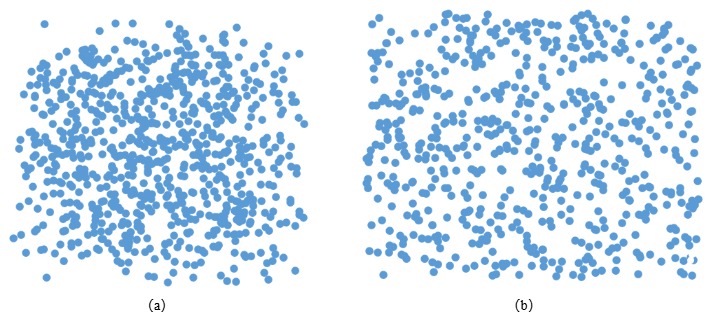
In order to intuitively demonstrate the effect of the contrastive disentanglement attributes learning method, we conducted visualization experiments. As shown in Figure 3, we randomly selected an item and displayed the corresponding attribute distribution before and after disentanglement in the same space with the t-SNE [35] method. As shown in Figure 7(b), the attribute distributions are more spread out, highlighting that contrasting disentanglement attributes learning methods can improve attribute independence and enhance the interpretability of complementary recommendation tasks.
4.3. On complementary item retrieval (RQ3)
To validate the practicality of our work, we scientifically evaluated the performance of DICM-MD and w/o-Candidate on the complementary item retrieval task. We considered the given top as a “query” and randomly selected N bottoms as a candidate set, which contains one positive example and N-1 negative examples. A ranked list is generated by computing the compatibility score between the given top and bottom in the candidate set. In Figure 4, we showed the results of the ranking list of DICM-MD and the variant w/o-Candidate for 10 candidate bottoms based on the given query. The results show that the DICM-MD model proposed in this paper put the positive examples at the top compared to w/o-Candidate, which further proves that the candidate attribute compatibility modeling designed by us is effective. Therefore, the Diversified Interpretable Compatibility Modeling is necessary in the task of Complementary Item Retrieval.
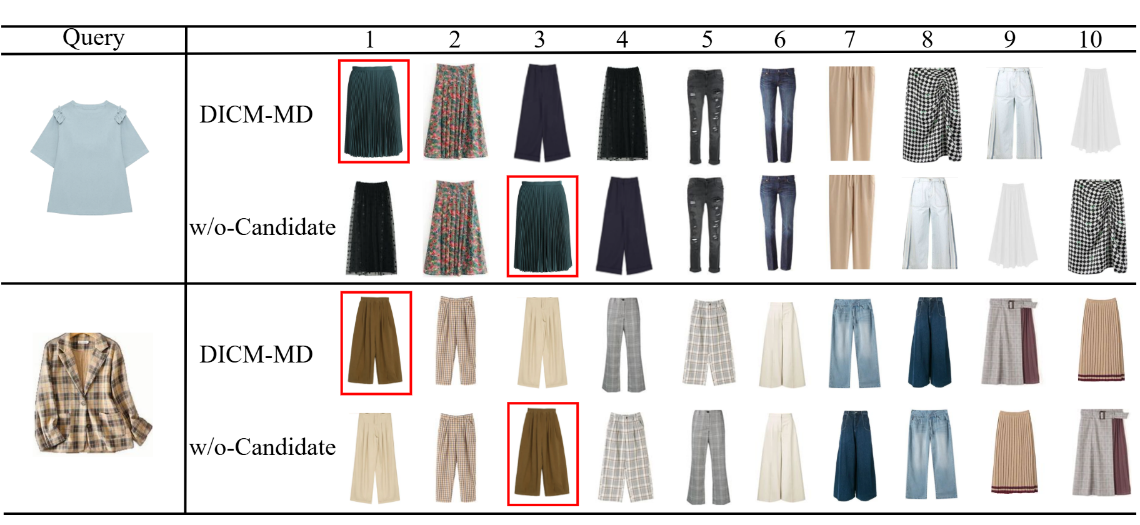
5. Conclusion and future work
In this paper, we present the DICM-MD model, which disentangles the multi-modal information of fashion items and uses the diversified interpretable compatibility modeling module to explore the interaction information of item attributes. Specifically, we propose a comparative disentanglement attribute learning method based on deep mutual information, which uses a neural network to fit the value of mutual information between attributes and designs a contrast loss to optimize this value and gradually improve the independence between attributes. To fully explore the attribute compatibility rules, we also designed aligned attribute compatibility modeling and candidate attribute compatibility modeling to learn complex attribute interactions from two perspectives.
References
[1]. Xie, Y., Lin, B., Qu, Y., Li, C., Zhang, W., Ma, L., ... & Tao, D. (2020). Joint deep multi-view learning for image clustering. IEEE Transactions on Knowledge and Data Engineering, 33(11), 3594-3606.
[2]. Wang, Y., Liu, L., Fu, X., & Liu, L. (2024). MCCP: multi-modal fashion compatibility and conditional preference model for personalized clothing recommendation. Multimedia Tools and Applications, 83(4), 9621-9645.
[3]. Yang, X., Ma, Y., Liao, L., Wang, M., & Chua, T. S. (2019, July). Transnfcm: Translation-based neural fashion compatibility modeling. In Proceedings of the AAAI conference on artificial intelligence (Vol. 33, No. 01, pp. 403 410).
[4]. Lin, Y. L., Tran, S., & Davis, L. S. (2020). Fashion outfit complementary item retrieval. In Proceedings of the IEEE/CVF conference on computer vision and pattern recognition (pp. 3311-3319).
[5]. De Divitiis, L., Becattini, F., Baecchi, C., & Del Bimbo, A. (2023). Disentangling features for fashion recommendation. ACM Transactions on Multimedia Computing, Communications and Applications, 19(1s), 1-21.
[6]. Guan, W., Wen, H., Song, X., Wang, C., Yeh, C. H., Chang, X., & Nie, L. (2022). Partially supervised compatibility modeling. IEEE Transactions on Image Processing, 31, 4733-4745.
[7]. Cui, Z., Yu, F., Wu, S., Liu, Q., & Wang, L. (2021). Disentangled item representation for recommender systems. ACM Transactions on Intelligent Systems and Technology (TIST), 12(2), 1–20.
[8]. Ma, J., Cui, P., Kuang, K., Wang, X., & Zhu, W. (2019). Disentangled graph convolutional networks. In International conference on machine learning (pp. 4212–4221). PMLR.
[9]. Liu, F., Chen, H., Cheng, Z., Liu, A., Nie, L., & Kankanhalli, M. (2022). Disentangled multimodal representation learning for recommendation. IEEE Transactions on Multimedia, 25, 7149–7159.
[10]. Cui, Z., Li, Z., Wu, S., Zhang, X.-Y., & Wang, L. (2019). Dressing as a whole: Outfit compatibility learning based on node-wise graph neural networks. In The World Wide Web Conference (pp. 307–317).
[11]. Guo, Z., Li, J., Li, G., Wang, C., Shi, S., & Ruan, B. (2024). Lgmrec: Local and global graph learning for multimodal recommendation. Proceedings of the AAAI Conference on Artificial Intelligence, 38(8), 8454–8462.
[12]. Jing, P., Cui, K., Guan, W., Nie, L., & Su, Y. (2023). Category-aware multimodal attention network for fashion compatibility modeling. IEEE Transactions on Multimedia, 25, 9120–9131.
[13]. Shimizu, R., Wang, Y., Kimura, M., Hirakawa, Y., Wada, T., Saito, Y., & McAuley, J. (2024). A fashion item recommendation model in hyperbolic space. In Proceedings of the IEEE/CVF Conference on Computer Vision and Pattern Recognition (pp. 8377–8383).
[14]. Yang, X., Song, X., Feng, F., Wen, H., Duan, L.-Y., & Nie, L. (2021). Attribute-wise explainable fashion compatibility modeling. ACM Transactions on Multimedia Computing, Communications, and Applications (TOMM), 17(1), 1–21.
[15]. Wang, X., Chen, H., & Zhu, W. (2021). Multimodal disentangled representation for recommendation. In 2021 IEEE International Conference on Multimedia and Expo (ICME) (pp. 1–6). IEEE.
[16]. Tangseng, P., Yamaguchi, K., & Okatani, T. (2017). Recommending outfits from personal closet. In Proceedings of the IEEE International Conference on Computer Vision Workshops (pp. 2275–2279).
[17]. He, R., & McAuley, J. (2016). Vbpr: visual bayesian personalized ranking from implicit feedback. Proceedings of the AAAI conference on artificial intelligence, 30(1).
[18]. Li, Y., Cao, L., Zhu, J., & Luo, J. (2017). Mining fashion outfit composition using an end-to-end deep learning approach on set data. IEEE Transactions on Multimedia, 19(8), 1946–1955.
[19]. Nakamura, T., & Goto, R. (2018). Outfit generation and style extraction via bidirectional lstm and autoencoder. arXiv preprint arXiv: 1807.03133.
[20]. Gao, R., Tao, Y., Yu, Y., Wu, J., Shao, X., Li, J., & Ye, Z. (2023). Self-supervised dual hypergraph learning with intent disentanglement for session-based recommendation. Knowledge-Based Systems, 270, 110528.
[21]. Wang, X., Jin, H., Zhang, A., He, X., Xu, T., & Chua, T.-S. (2020). Disentangled graph collaborative filtering. In Proceedings of the 43rd international ACM SIGIR conference on research and development in information retrieval (pp. 1001–1010).
[22]. Wang, Y., Tang, S., Lei, Y., Song, W., Wang, S., & Zhang, M. (2020). Disenhan: Disentangled heterogeneous graph attention network for recommendation. In Proceedings of the 29th ACM international conference on information & knowledge management (pp. 1605–1614).
[23]. Yang, F., Chen, C., Wang, Z., Chen, H., Liu, Y., Li, G., & Wu, X. (2023). Vit-based terrain recognition system for wearable soft exosuit. Biomimetic Intelligence and Robotics, 3(1), 100087.
[24]. Bana, T., Loya, J., & Kulkarni, S. (2021). Vit-inception-gan for image colourising. arXiv preprint arXiv: 2106.06321.
[25]. Yang, X., Ma, Y., Liao, L., Wang, M., & Chua, T.-S. (2019). Transnfcm: Translation-based neural fashion compatibility modeling. Proceedings of the AAAI conference on artificial intelligence, 33(01), 403–410.
[26]. Belghazi, M. I., Baratin, A., Rajeshwar, S., Ozair, S., Bengio, Y., Courville, A., & Hjelm, D. (2018). Mutual information neural estimation. In International conference on machine learning (pp. 531–540). PMLR.
[27]. Cheng, P., Hao, W., Dai, S., Liu, J., Gan, Z., & Carin, L. (2020). Club: A contrastive log-ratio upper bound of mutual information. In International conference on machine learning (pp. 1779–1788). PMLR.
[28]. Paninski, L. (2003). Estimation of entropy and mutual information. Neural computation, 15(6), 1191–1253.
[29]. Cremonesi, P., Koren, Y., & Turrin, R. (2010). Performance of recommender algorithms on top-n recommendation tasks. In Proceedings of the fourth ACM conference on Recommender systems (pp. 39–46).
[30]. Zhao, W. X., Hou, Y., Pan, X., Yang, n., Che, u., Zhang, Zey, Lin, Z., Zhang, J., Bian, S., Tang, i., Jiaka, W., Sun, et al. (2022). Recbole 2.0: towards a more up-to-date recommendation library. In Proceedings of the 31st ACM International Conference on Information & Knowledge Management (pp. 4722–4726).
[31]. Han, X., Wu, Z., Jiang, Y.-G., & Davis, L. S. (2017). Learning fashion compatibility with bidirectional lstms. In Proceedings of the 25th ACM international conference on Multimedia (pp. 1078–1086).
[32]. Zhou, Z., Su, Z., & Wang, R. (2022). Attribute-aware heterogeneous graph network for fashion compatibility prediction. Neurocomputing, 495, 62–74.
[33]. Lu, S., Zhu, X., Wu, Y., Wan, X., & Gao, F. (2021). Outfit compatibility prediction with multi-layered feature fusion network. Pattern Recognition Letters, 147, 150–156.
[34]. Sagar, D., Garg, J., Kansal, P., Bhalla, S., Shah, R. R., & Yu, Y. (2020). Pai-bpr: Personalized outfit recommendation scheme with attribute-wise interpretability. In 2020 IEEE Sixth International Conference on Multimedia Big Data (BigMM) (pp. 221–230). IEEE.
[35]. Van der Maaten, L., & Hinton, G. (2008). Visualizing data using t-sne. Journal of machine learning research, 9(11).
Cite this article
Sun,S.;Yu,M.;Yu,X. (2025). Diversified Interpretable Compatibility Modeling Based on Multi-modal Disentanglement. Applied and Computational Engineering,163,65-78.
Data availability
The datasets used and/or analyzed during the current study will be available from the authors upon reasonable request.
Disclaimer/Publisher's Note
The statements, opinions and data contained in all publications are solely those of the individual author(s) and contributor(s) and not of EWA Publishing and/or the editor(s). EWA Publishing and/or the editor(s) disclaim responsibility for any injury to people or property resulting from any ideas, methods, instructions or products referred to in the content.
About volume
Volume title: Proceedings of the 3rd International Conference on Software Engineering and Machine Learning
© 2024 by the author(s). Licensee EWA Publishing, Oxford, UK. This article is an open access article distributed under the terms and
conditions of the Creative Commons Attribution (CC BY) license. Authors who
publish this series agree to the following terms:
1. Authors retain copyright and grant the series right of first publication with the work simultaneously licensed under a Creative Commons
Attribution License that allows others to share the work with an acknowledgment of the work's authorship and initial publication in this
series.
2. Authors are able to enter into separate, additional contractual arrangements for the non-exclusive distribution of the series's published
version of the work (e.g., post it to an institutional repository or publish it in a book), with an acknowledgment of its initial
publication in this series.
3. Authors are permitted and encouraged to post their work online (e.g., in institutional repositories or on their website) prior to and
during the submission process, as it can lead to productive exchanges, as well as earlier and greater citation of published work (See
Open access policy for details).
References
[1]. Xie, Y., Lin, B., Qu, Y., Li, C., Zhang, W., Ma, L., ... & Tao, D. (2020). Joint deep multi-view learning for image clustering. IEEE Transactions on Knowledge and Data Engineering, 33(11), 3594-3606.
[2]. Wang, Y., Liu, L., Fu, X., & Liu, L. (2024). MCCP: multi-modal fashion compatibility and conditional preference model for personalized clothing recommendation. Multimedia Tools and Applications, 83(4), 9621-9645.
[3]. Yang, X., Ma, Y., Liao, L., Wang, M., & Chua, T. S. (2019, July). Transnfcm: Translation-based neural fashion compatibility modeling. In Proceedings of the AAAI conference on artificial intelligence (Vol. 33, No. 01, pp. 403 410).
[4]. Lin, Y. L., Tran, S., & Davis, L. S. (2020). Fashion outfit complementary item retrieval. In Proceedings of the IEEE/CVF conference on computer vision and pattern recognition (pp. 3311-3319).
[5]. De Divitiis, L., Becattini, F., Baecchi, C., & Del Bimbo, A. (2023). Disentangling features for fashion recommendation. ACM Transactions on Multimedia Computing, Communications and Applications, 19(1s), 1-21.
[6]. Guan, W., Wen, H., Song, X., Wang, C., Yeh, C. H., Chang, X., & Nie, L. (2022). Partially supervised compatibility modeling. IEEE Transactions on Image Processing, 31, 4733-4745.
[7]. Cui, Z., Yu, F., Wu, S., Liu, Q., & Wang, L. (2021). Disentangled item representation for recommender systems. ACM Transactions on Intelligent Systems and Technology (TIST), 12(2), 1–20.
[8]. Ma, J., Cui, P., Kuang, K., Wang, X., & Zhu, W. (2019). Disentangled graph convolutional networks. In International conference on machine learning (pp. 4212–4221). PMLR.
[9]. Liu, F., Chen, H., Cheng, Z., Liu, A., Nie, L., & Kankanhalli, M. (2022). Disentangled multimodal representation learning for recommendation. IEEE Transactions on Multimedia, 25, 7149–7159.
[10]. Cui, Z., Li, Z., Wu, S., Zhang, X.-Y., & Wang, L. (2019). Dressing as a whole: Outfit compatibility learning based on node-wise graph neural networks. In The World Wide Web Conference (pp. 307–317).
[11]. Guo, Z., Li, J., Li, G., Wang, C., Shi, S., & Ruan, B. (2024). Lgmrec: Local and global graph learning for multimodal recommendation. Proceedings of the AAAI Conference on Artificial Intelligence, 38(8), 8454–8462.
[12]. Jing, P., Cui, K., Guan, W., Nie, L., & Su, Y. (2023). Category-aware multimodal attention network for fashion compatibility modeling. IEEE Transactions on Multimedia, 25, 9120–9131.
[13]. Shimizu, R., Wang, Y., Kimura, M., Hirakawa, Y., Wada, T., Saito, Y., & McAuley, J. (2024). A fashion item recommendation model in hyperbolic space. In Proceedings of the IEEE/CVF Conference on Computer Vision and Pattern Recognition (pp. 8377–8383).
[14]. Yang, X., Song, X., Feng, F., Wen, H., Duan, L.-Y., & Nie, L. (2021). Attribute-wise explainable fashion compatibility modeling. ACM Transactions on Multimedia Computing, Communications, and Applications (TOMM), 17(1), 1–21.
[15]. Wang, X., Chen, H., & Zhu, W. (2021). Multimodal disentangled representation for recommendation. In 2021 IEEE International Conference on Multimedia and Expo (ICME) (pp. 1–6). IEEE.
[16]. Tangseng, P., Yamaguchi, K., & Okatani, T. (2017). Recommending outfits from personal closet. In Proceedings of the IEEE International Conference on Computer Vision Workshops (pp. 2275–2279).
[17]. He, R., & McAuley, J. (2016). Vbpr: visual bayesian personalized ranking from implicit feedback. Proceedings of the AAAI conference on artificial intelligence, 30(1).
[18]. Li, Y., Cao, L., Zhu, J., & Luo, J. (2017). Mining fashion outfit composition using an end-to-end deep learning approach on set data. IEEE Transactions on Multimedia, 19(8), 1946–1955.
[19]. Nakamura, T., & Goto, R. (2018). Outfit generation and style extraction via bidirectional lstm and autoencoder. arXiv preprint arXiv: 1807.03133.
[20]. Gao, R., Tao, Y., Yu, Y., Wu, J., Shao, X., Li, J., & Ye, Z. (2023). Self-supervised dual hypergraph learning with intent disentanglement for session-based recommendation. Knowledge-Based Systems, 270, 110528.
[21]. Wang, X., Jin, H., Zhang, A., He, X., Xu, T., & Chua, T.-S. (2020). Disentangled graph collaborative filtering. In Proceedings of the 43rd international ACM SIGIR conference on research and development in information retrieval (pp. 1001–1010).
[22]. Wang, Y., Tang, S., Lei, Y., Song, W., Wang, S., & Zhang, M. (2020). Disenhan: Disentangled heterogeneous graph attention network for recommendation. In Proceedings of the 29th ACM international conference on information & knowledge management (pp. 1605–1614).
[23]. Yang, F., Chen, C., Wang, Z., Chen, H., Liu, Y., Li, G., & Wu, X. (2023). Vit-based terrain recognition system for wearable soft exosuit. Biomimetic Intelligence and Robotics, 3(1), 100087.
[24]. Bana, T., Loya, J., & Kulkarni, S. (2021). Vit-inception-gan for image colourising. arXiv preprint arXiv: 2106.06321.
[25]. Yang, X., Ma, Y., Liao, L., Wang, M., & Chua, T.-S. (2019). Transnfcm: Translation-based neural fashion compatibility modeling. Proceedings of the AAAI conference on artificial intelligence, 33(01), 403–410.
[26]. Belghazi, M. I., Baratin, A., Rajeshwar, S., Ozair, S., Bengio, Y., Courville, A., & Hjelm, D. (2018). Mutual information neural estimation. In International conference on machine learning (pp. 531–540). PMLR.
[27]. Cheng, P., Hao, W., Dai, S., Liu, J., Gan, Z., & Carin, L. (2020). Club: A contrastive log-ratio upper bound of mutual information. In International conference on machine learning (pp. 1779–1788). PMLR.
[28]. Paninski, L. (2003). Estimation of entropy and mutual information. Neural computation, 15(6), 1191–1253.
[29]. Cremonesi, P., Koren, Y., & Turrin, R. (2010). Performance of recommender algorithms on top-n recommendation tasks. In Proceedings of the fourth ACM conference on Recommender systems (pp. 39–46).
[30]. Zhao, W. X., Hou, Y., Pan, X., Yang, n., Che, u., Zhang, Zey, Lin, Z., Zhang, J., Bian, S., Tang, i., Jiaka, W., Sun, et al. (2022). Recbole 2.0: towards a more up-to-date recommendation library. In Proceedings of the 31st ACM International Conference on Information & Knowledge Management (pp. 4722–4726).
[31]. Han, X., Wu, Z., Jiang, Y.-G., & Davis, L. S. (2017). Learning fashion compatibility with bidirectional lstms. In Proceedings of the 25th ACM international conference on Multimedia (pp. 1078–1086).
[32]. Zhou, Z., Su, Z., & Wang, R. (2022). Attribute-aware heterogeneous graph network for fashion compatibility prediction. Neurocomputing, 495, 62–74.
[33]. Lu, S., Zhu, X., Wu, Y., Wan, X., & Gao, F. (2021). Outfit compatibility prediction with multi-layered feature fusion network. Pattern Recognition Letters, 147, 150–156.
[34]. Sagar, D., Garg, J., Kansal, P., Bhalla, S., Shah, R. R., & Yu, Y. (2020). Pai-bpr: Personalized outfit recommendation scheme with attribute-wise interpretability. In 2020 IEEE Sixth International Conference on Multimedia Big Data (BigMM) (pp. 221–230). IEEE.
[35]. Van der Maaten, L., & Hinton, G. (2008). Visualizing data using t-sne. Journal of machine learning research, 9(11).









